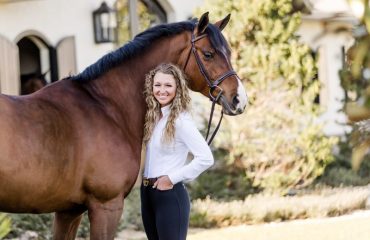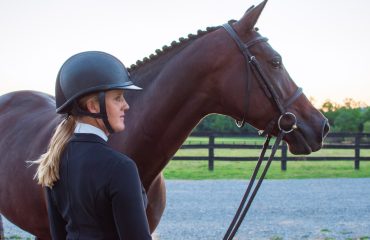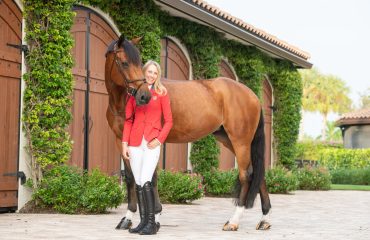By Lauren R. Giannini
Photos by Stephen Thurston, www.stephenthurstonphotography.com
Sue Blackmore is an accomplished rider who for nearly 20 years has served as whipper-in (field assistant) to her husband, Martyn Blackmore, huntsman since 2014 for the Lowcountry Hunt in Jacksonboro, South Carolina. Sue’s primary hunt horse, Dustin, proved he was equally good therapy after her bilateral mastectomy and reconstruction surgery in 2011.
The Blackmores are British. Sue started riding at 14, qualified at 19 as a British Horse Society Assistant Instructor and at 21, made her debut in the hunt field.
Sue and Martyn initially met 25-plus years ago. He spent 14 years working as first whipper-in and kennel huntsman with various British packs while learning the art and craft of hunting. In 1996, he applied for a job with Mr. Jeffords’ Hounds in Wyoming. Sue and Martyn got together as a couple about three months before they packed and moved to the U.S. with two dogs in September 1997. Martyn proposed on Valentine’s Day, 1998. They married that June.
Martyn’s profession took them from Wyoming to Santa Ynez, California, then east for seven seasons at Loudoun West and one at Loudoun Hunt, both in Virginia. That’s where Sue battled breast cancer.
“Being British, I’m very stiff upper lip, but I do feel things deeply and I know how very fortunate I am,” said Sue. “I have to say that Martyn has been with me every step of the way. He’s been my shoulder to lean on and given me strength. I have wonderful friends whose kindness and help I can never repay. And I had Dustin, my horse of a lifetime.”
Dire Diagnosis
In 2006, Sue and Martyn were relocating from California to Virginia. Sue had boarded field hunters for several hunt members and became close friends with Marian Honeyman, whose horse was Dustin, a 3-year-old pink (strawberry roan) gelding by a Thoroughbred out of a Quarter Horse-Percheron mare. Sue didn’t really like him, because he ran away whenever she tried to catch him. She did, however, enjoy putting many hours under saddle into him. Marian took Dustin on trails, riding Western as well as English, and introduced him to the hunt field. The day he bucked her off, Marian decided to go back to Thoroughbreds.
“After we moved, I needed a horse,” said Sue. “Martyn and I hadn’t been in Virginia long when I got a call from Marian, generously offering me Dustin for $1, including shipping him to Virginia. It wasn’t until he arrived toward the end of summer 2006 that I realized I was very lucky to have this horse of a different color. About the same time, I was diagnosed with breast cancer.”
Sue had gone to register with a new primary care doctor. “I palpated regularly, but I didn’t find the tumor — it was small and deep against my rib wall,” she said. “The doctor said it was a lucky find. I had three lumpectomies in 10 weeks. Each time the margins were still a little too much. They started me on radiation treatment for 7½ weeks and, after that, all was good; I was clear. I saw a very good oncologist every three or four months and every year for five years, I had a mammogram and MRI.
“The sixth year, the insurance company questioned my wanting to have the MRI. I felt it was important,” continued Sue. “That MRI showed that I had another tumor in the same area as the original one. I think you have to trust your doctors and your professionals. My oncologist suggested a mastectomy. I decided to have a bilateral mastectomy and reconstruction with a DIEP (Deep Inferior Epigastric Perforator) flap. I was in surgery for 18 hours.”
Sue has a down-to-earth, pragmatic “let’s get the job done” attitude. She speaks with a charming accent, albeit with a determined edge. She applied the same determination to herself post-surgery.
“I always had a positive attitude, always looked for light at the end of the tunnel. I had my own mantras,” said Sue. “After surgery, I spent four days in hospital. My reconstructive surgeon was an artist the way he rebuilt my breasts. I wasn’t allowed to do anything. I even needed help to get out of bed. They sent me home with a belt around my waist that automatically dispensed Lidocaine into my abdomen through a tube. I had four drains in case of fluid build-up and a row of sutures hip to hip. I lived in baggy pajamas. I couldn’t do anything outside, except walk. I wasn’t allowed to straighten my back for four months. Our very good friend, Kim Yager, rented an electrically-operated chair that lay me down and sat me up. I slept in it for six weeks. I was very lucky to have a supportive husband and good friends. They brought food and worked out a roster of who did supper, who did the cleaning.”
The Best Therapy
Being a horse person, Sue started doing things before the surgeon gave her the green light. She made sure not to lift more than 5 pounds and she didn’t raise her arms above shoulder height. Dixie Miliner, who came every other day, drank tea with Sue and massaged her aching back.
“Jill Adler took care of my horses and made sure Martyn’s horse was always ready for him on hunting days,” said Sue. “I could see everything from the sitting room window — my horses and the barn. I was very frustrated, not being accustomed to inactivity. I started walking, twice a day, initially with Martyn holding my arm as I was very weak. I kept at it and started going out by myself, usually when no one could see me shuffling around in my unfashionable attire. I went a little further each time.
“About a month after surgery, I made it to the barn. It was an emotional reunion,” continued Sue. “My horse always recognizes me and does a really quiet whicker. You can’t really hear it, but you can see his lips and nostrils move. That first time, I didn’t go into his stall. I just cradled Dustin’s head over the half-door and cried like a baby. I’m more spiritual than religious, but I did thank God that I was still here to see my horses.”
The third or fourth time to the barn, Sue went into the stall and leaned on Dustin’s shoulder. He sniffed at the drains, flaring his nostrils. “I didn’t cry after the first time I made it to the barn,” said Sue. “When I was first diagnosed with breast cancer, Martyn and I cried together. When I got the call that my surgery was scheduled for 19th October 2011, I was on the way to clip a horse and Martyn was back at the kennels, walking hounds. I stopped the car to take the call and stayed there, feeling physically nauseous while I rang Martyn to let him know. Later, he told me he felt physically ill whilst I was talking to him. We’re very close telepathically, which I know helps when I whip in.”
Sue didn’t start riding until the following June. She wanted to ride more than anything, but felt extremely frightened. “I had lost all my confidence, but it was something I felt I had to do,” said Sue. “One day, I told Martyn that I’d like to try riding. He tacked up Dustin for me, took him to the mounting block and stood at his head. I swung my leg over and sat there. I welled up, but I didn’t bawl the way I did the first time I got to the barn. We just walked. Sometimes Dustin trips, but that day he didn’t. I think he knew he had a precious passenger.

Sue spends a sweet moment with Dustin, her strawberry roan (pink!) horse who was her therapy during her recovery from breast cancer.
“I did a little every day and eventually started trotting and cantering,” continued Sue. “I was back whipping-in to Martyn in September. Dustin has a bit of a shy, so, fast or slow, I always ride defensively. I was still nervous about jumping, but he’s the best horse for going through gates without dismounting. The following season I started jumping more, and now I’m back to 100 percent confidence. That horse was my therapy. I wouldn’t have gone back to hunting if I hadn’t had Dustin to ride. I’m happiest when I’m active. I feel extremely fortunate. Life is very, very good.”
















